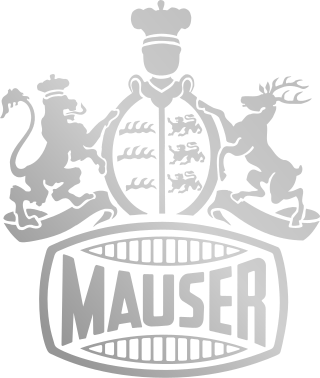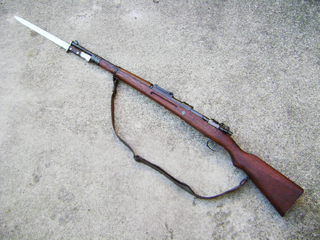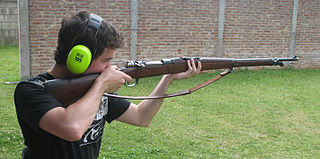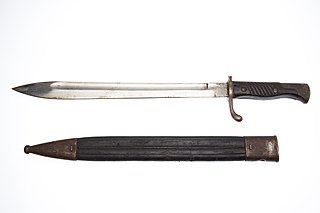
The Karabiner 98 kurz, often abbreviated Karabiner 98k, Kar98k or K98k and also sometimes incorrectly referred to as a K98, is a bolt-action rifle chambered for the 7.92×57mm Mauser cartridge. It was adopted on 21 June 1935 as the standard service rifle by the German Wehrmacht. It was one of the final developments in the long line of Mauser military rifles.

Mauser, originally the Königlich Württembergische Gewehrfabrik, was a German arms manufacturer. Their line of bolt-action rifles and semi-automatic pistols was produced beginning in the 1870s for the German armed forces. In the late 19th and early 20th centuries, Mauser designs were also exported and licensed to many countries, which adopted them as military and civilian sporting firearms. The Gewehr 98 in particular was widely adopted and copied, and it is the foundation of many of today's sporting bolt-action rifles.

Peter Paul von Mauser was a German weapon designer, manufacturer, industrialist and politician.

The Gewehr 98 is a bolt-action rifle made by Mauser for the German Empire as its service rifle from 1898 to 1935.

The Karabinek wz.29 was a Polish bolt-action short rifle based on the German Kar98AZ. Identifying attributes include a 98/05 style mast bayonet lug ending directly beneath the front sight and winged protective ears to either side of the front sight blade. Cavalry models featured a turned-down bolt handle, and early versions had a stacking hook near the end of the stock on the right side.

The Gewehr 88 was a late 19th-century German bolt-action rifle, adopted in 1888.

The Mauser Model 1871 adopted as the Gewehr 71 or Infanterie-Gewehr 71, or "Infantry Rifle 71" was the first rifle model in a distinguished line designed and manufactured by Paul Mauser and Wilhelm Mauser of the Mauser company and later mass-produced at Spandau arsenal.
The evolution of German military rifles is a history of common and diverse paths followed by the separate German states, until the mid-19th century when Prussia emerged as the dominant state within Germany and the nation was unified. This article discusses rifled shoulder arms developed in or for the military of the states that later became Germany; it excludes firearms of the Austrian Empire, except where they were used substantially by German troops.

The Hanyang M1935 bayonet is a bayonet used on the Chinese Chiang Kai-Shek rifle. It is based on the Mauser S84/98 III bayonet used on German Gewehr 98 rifles and derivatives and utilizes the same Mauser bayonet lug pattern.

The Mauser Model 1889 is a bolt-action rifle of Belgian origin. It became known as the 1889 Belgian Mauser, 1891 Argentine Mauser, and 1890 Turkish Mauser.

The Seitengewehr 42, otherwise known as the Seitengewehr Modell 42 or in English the Bayonet Model 1942, was developed in 1942 by Wilhelm Gustloff Werke and manufactured by Carl Eickhorn in Solingen. According to its description, the Gustloff Company and its chief designer, Carl Barnitzke, got a German patent 766198 in October 1942 for an Armeemesser according to its description. The SG 42 was intended to supplement and later replace the original S84/98 III bayonet of the Karabiner 98k service rifle. The Seitengewehr 42 was designed as a multi-tool combat knife, but could also be mounted as a bayonet on the Karabiner 98k. The S84/98 III bayonet itself was a proven design, but there was a shortage of utility knives in the German military, which were usually procured privately.
Spandau Arsenal was the center for development of military small arms for Imperial Germany from the Industrial Revolution until 1919. Spandau engineered and tested improved infantry weapons.
The Mauser Model 1904 and Model 1907 were Gewehr 98 pattern bolt-action rifles produced by Mauser and Deutsche Waffen und Munitionsfabriken (DWM). They were designed for export market. Copies were later produced in China and in Spain.

The Argentine Mauser Model 1909 were Gewehr 98 pattern bolt-action battle rifles designed for the Argentine Army. They were produced both in Germany and in Argentina.

The Seitengewehr 98, also known as the "Butcher's Blade", is a bayonet used with the Gewehr 98 rifle by Germany. It was designed in response to the French Épée-Baïonnette Modèle 1886.












